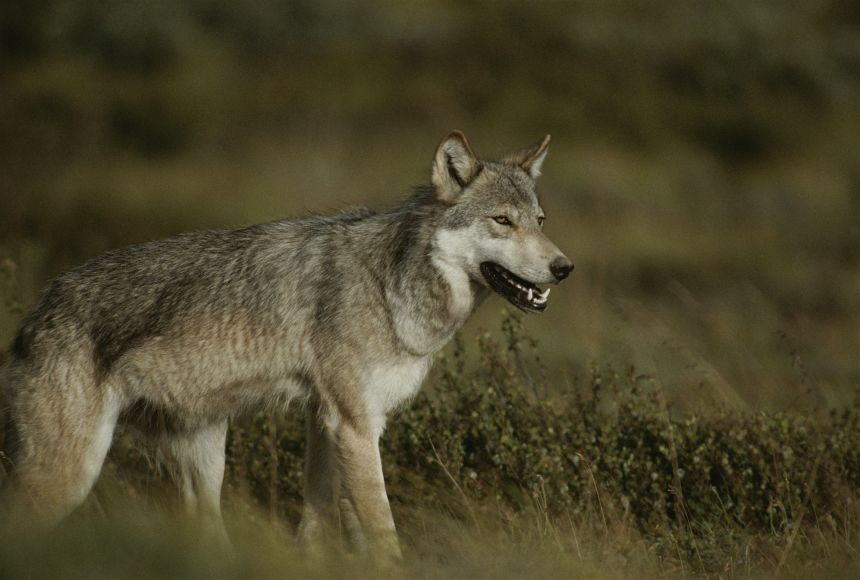The booming fur trade of the 19th century catalyzed westward expansion and helped establish the United States as a rising force in the global economy. However, it also took a toll on wildlife; not only did it affect the animal populations coveted for their soft furs (for example, sea otters [Enhydra lutris]), but it also affected the broader food web. In the case of sea otters, overhunting decimated the sea otter population, and the removal of this top predator from its environment had a negative effect that cascaded down throughout the ecosystem. Due to these lingering effects on the food web, sea otter populations have since had a hard time rebounding.
This is just one example of how a human-made, near-extinction event has altered complex multiorganism dynamics connected with a top predator. In several ecosystems, over-hunting has left once-top predators unable to regain a foothold in their previous ecosystems.
The sea otter is an apex predator, a carnivore at the top of its local food chain. The southern sea otter population off the U.S. California coast dropped from more than 10,000 in the 1700s to fewer than 100 by the early 1900s. North American participation in the global fur trade heavily influenced this near-extinction. As U.S. society has evolved to prioritize species conservation efforts and regulate activities, such as the harvesting of furs, people have gained interest in the preservation and reintroduction of once-hunted apex predators. However, the damage to the ecosystem has taken its toll.
When the otter population dropped during the fur-trade era, it initiated a cascade of events that altered the region’s food web. Populations of sea urchins and other marine invertebrates, natural prey to sea otters, skyrocketed. This bloated population of invertebrates ate away whole forests of kelp to support themselves. The shrinking forests of algal seaweed forced fish, which used to find shelter within them, into alternate habitats. The absence of sea otters from the food web resulted in decreased ecosystem diversity. This type of relationship within a food web, in which the feeding habits of a predator trickle down and influence lower levels of the food web beyond the predator’s immediate prey, is called a trophic cascade.
A decline in the gray wolf (Canis lupus) population had a similar effect in the U.S. northwest. In the 1900s, settlers competed with wolves for large prey, such as bison and deer, and hungry wolves inevitably began instead to prey on livestock and were thus hunted themselves by ranchers protecting their flocks. The loss of gray wolves led to an explosion of the elk (Cervus canadensis) population and subsequent overgrazing of plants, including immature trees. This loss of vegetation negatively impacted beaver and bird populations. Without enough plants to hold the soil together or shade the ground, the overgrazing of the area also led to river bank erosion and changes in water temperature due to lack of shading.
As scientists have learned more about trophic cascades, they have begun to discuss and implement efforts to reintroduce some top predators back into their ecosystems. For example, the U.S. National Park Service reintroduced wolves into Yellowstone National Park beginning in the mid-1990s, dramatically stabilizing some aspects of the food web and ecosystem. Repercussions included a decrease in the once overabundant elk population, a downstream increase in vegetation growth, and a rebound in the populations of smaller animals. It also affected mortality trends in the elk population. Now, young elk no longer die in bulk from starvation during winter. Instead, predation heavily influences mortality throughout the year.
However, the path back to a stable food web is not always the reverse of the environmental pathway that led to destabilization. This phenomenon, when the path to recovery differs from the path of disruption, is called hysteresis. In the case of the Yellowstone wolves, reintroduction has been largely successful and has reversed some of the ecological imbalance, but the balance within the food web may never return to its original stable state. In the case of the sea otter and other recent examples, reestablishment of the population and previous food web dynamics have been more complex.
In Central California, southern sea otter populations have rebounded to close to 3,000 individuals (from fewer than 100 a century ago). However, range expansion has not been as successful as repopulation, and some sources indicate that ecosystem changes are to blame. For example, during the long otter absence, sea urchins have consumed huge patches of kelp that once served as shelter for many animals. When modern otters venture into these now barren areas, sharks may easily spot them, leading to deadly encounters. However, the reintroduction of otters in the northern Pacific near Alaska has shown similar success to that of the gray wolf in Yellowstone: Sea urchin numbers have decreased, kelp forests are beginning to expand, and marine biodiversity is increasing.
In other cases, reintroduction of predators has had less successful results. For example, African wild dogs (Lycaon pictus) reintroduced to various parts of continent, where they were once apex predators, failed to induce trophic cascades or improve ecosystem stability. More concerning, the reintroduction of the brown bear (Ursus arctos) population in the Pyrenees mountain range in Europe resulted in negative consequences—in particular, increased attacks on livestock, which cost local governments a great deal in compensation expenses. These examples illustrate the complexity of trophic cascades and the often unpredictable ways in which predators affect their ecosystems and food web dynamics, tempering ideas about future opportunities to reintroduce predators to solve ecosystem problems.
